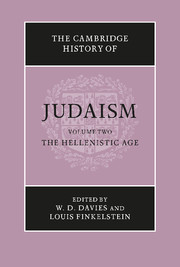Book contents
- Frontmatter
- 1 The archeology of Hellenistic Palestine
- 2 The political and social History of Palestine from Alexander to Antiochus III (333–187 B.C.E.)
- 3 Hebrew, Aramaic and Greek in the Hellenistic age
- 4 The Diaspora in the Hellenistic age
- 5 The interpenetration of Judaism and Hellenism in the pre-Maccabean period
- 6 The men of the Great Synagogue (circa 400–170 .b.c.e.)
- 7 Pharisaic leadership after the Great Synagogue (170 B.C.E.–135 C.E.)
- 8 Antiochus IV
- 9 The Hasmonean revolt and the Hasmonean dynasty
- 10 Jewish literature in Hebrew and Aramaic in the Greek era
- 11 Jewish–Greek literature of the Greek period
- 12 The Apocrypha and Pseudepigrapha of the Hellenistic period
- 13 The book of Daniel
- 14 The matrix of apocalyptic
- 15 The Septuagint and its Hebrew text
- 16 The Targumim
- 17 The Samaritans
- 18 The growth of anti-Judaism or the Greek attitude towards the Jews
- Bibliographies
- Chronological table
- Index
- References
1 - The archeology of Hellenistic Palestine
Published online by Cambridge University Press: 28 March 2008
- Frontmatter
- 1 The archeology of Hellenistic Palestine
- 2 The political and social History of Palestine from Alexander to Antiochus III (333–187 B.C.E.)
- 3 Hebrew, Aramaic and Greek in the Hellenistic age
- 4 The Diaspora in the Hellenistic age
- 5 The interpenetration of Judaism and Hellenism in the pre-Maccabean period
- 6 The men of the Great Synagogue (circa 400–170 .b.c.e.)
- 7 Pharisaic leadership after the Great Synagogue (170 B.C.E.–135 C.E.)
- 8 Antiochus IV
- 9 The Hasmonean revolt and the Hasmonean dynasty
- 10 Jewish literature in Hebrew and Aramaic in the Greek era
- 11 Jewish–Greek literature of the Greek period
- 12 The Apocrypha and Pseudepigrapha of the Hellenistic period
- 13 The book of Daniel
- 14 The matrix of apocalyptic
- 15 The Septuagint and its Hebrew text
- 16 The Targumim
- 17 The Samaritans
- 18 The growth of anti-Judaism or the Greek attitude towards the Jews
- Bibliographies
- Chronological table
- Index
- References
Summary
In Palestine, as in the whole Near East, it was not that the curtain rose abruptly on the new world of Hellenism at the time of Alexander's expedition. The Macedonian soldiers only overturned barriers which were already offering only feeble resistance to the interpenetration of the Greek and Jewish worlds. In some respects there was in the cultural life of Israel no break in continuity between the Persian period and the Hellenistic age. It was just that what previously was only an incipient influence was to become a major force.
From this time on the new ways of life introduced by the Greeks broke upon the Orient. In Palestine, under the favourable auspices of the long period of peace – almost a whole century – which followed the advent of the Ptolemies, the new ways were to flourish. By means of all kinds of contacts, and particularly thanks to the development of commerce, Hellenism infiltrated on all sides in varying degrees.
From an archeological point of view, the penetration of Hellenism was evident everywhere. First in military installations: the immense superiority of Greco-Macedonian martial techniques necessitated the perfecting and extension of the defensive system. Similarly in dwelling places: the settlement of Greek colonists, who brought with them their standards of comfort and the refined tastes of ruling classes who had known the ostentation of Alexandria and the oriental capitals, was at the root of the development of domestic architecture and of the expansion of decorative refinements. The latter used artistic themes of the Hellenistic koinē, like those to be found on funerary monuments.
- Type
- Chapter
- Information
- The Cambridge History of Judaism , pp. 1 - 34Publisher: Cambridge University PressPrint publication year: 1990



